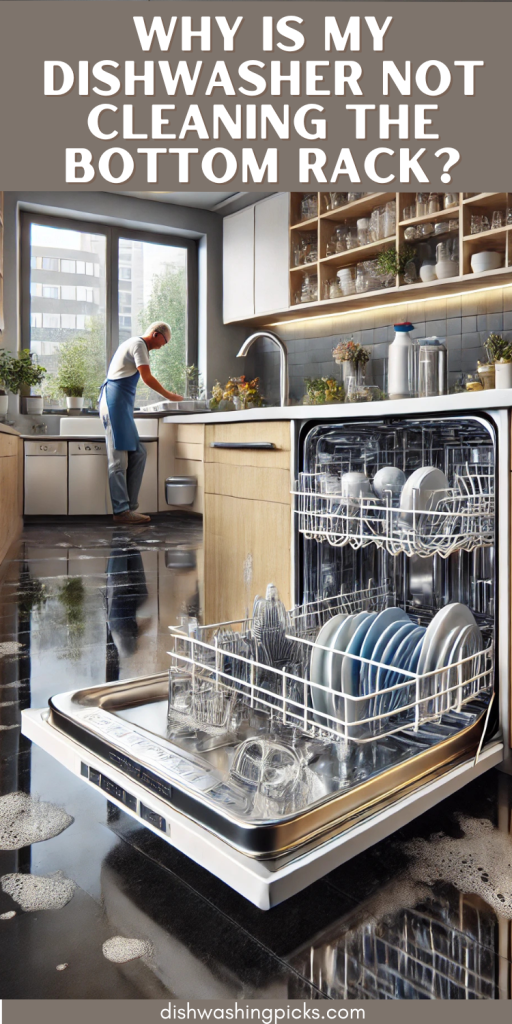
There’s nothing more frustrating than unloading your dishwasher only to find that the dishes on the bottom rack are still covered in gunk. It’s like your dishwasher just decided, “Nah, I’m taking the day off.” But don’t worry—I’ve got you covered. Let’s break it down and figure out what’s going on.
1. Clogged Spray Arms – The Sneaky Culprit
Ever noticed those spinning arms at the bottom of your dishwasher? Those little guys are responsible for blasting your dishes with water. But if they’re clogged with food debris, mineral buildup, or even (gasp!) bits of paper from labels, they won’t spray properly. No spray = no clean dishes.
Fix it:
- Remove the spray arms (check your dishwasher manual if you’re unsure how).
- Rinse them under running water and use a toothpick or a small brush to clear out any clogged holes.
- If there’s stubborn gunk, soak the arms in a vinegar solution for 15-30 minutes.
Still with me? Good. Because if it’s not the spray arms, there’s more to investigate.
2. Weak Water Pressure – A Dishwasher on a Diet?
Your dishwasher needs strong water pressure to scrub away grease and grime. If your home’s water pressure is low, or if there’s an issue with your dishwasher’s pump, the bottom rack might not be getting enough force to clean properly.
Check this:
- Run your kitchen sink and see if the water pressure seems weak. If it does, the issue might be with your home’s plumbing.
- If the sink’s pressure is fine, but the dishwasher still seems lazy, listen for the sound of water spraying inside. A weak or sputtering spray could mean a problem with the pump or motor.
If you’re nodding along like, “Yep, that sounds like my dishwasher,” don’t worry—we’ve still got more possible fixes to explore.
3. Overloading – The Classic Mistake
We’ve all been guilty of stuffing the dishwasher like it’s a suitcase before a long trip. But overloading can block the spray arms, preventing water from reaching the bottom rack.
How to load like a pro:
- Give your dishes some breathing room—don’t stack them too tightly.
- Make sure nothing (like a big pan) is blocking the spray arms from spinning.
- Avoid putting super dirty dishes on the top rack if your dishwasher only has one spray arm at the bottom. The grime could trickle down and make things worse.
Speaking of things getting in the way…
4. The Filter is Filthy – The Secret Dirt Trap
Dishwashers have a filter at the bottom that catches food particles to prevent clogging the drain. But if that filter is full of gunk, dirty water can’t drain properly—meaning it might just be swirling around your dishes instead of rinsing them clean.
Fix it:
- Locate the filter (usually at the bottom of the dishwasher).
- Take it out and give it a good rinse under warm water.
- Use a soft brush to scrub away any stuck-on food bits.
If you’ve done all this and your bottom rack is still underwhelming, there’s one more thing to check…
5. Detergent & Rinse Aid – Are You Using the Right Stuff?
Not all detergents are created equal. Some cheaper ones might not dissolve properly, leaving residue behind. Also, if you’re not using rinse aid, your dishwasher may struggle to rinse away all the grime effectively.
Quick fixes:
- Try switching to a high-quality detergent (preferably pods or powder over liquid).
- Use rinse aid to help water slide off dishes more effectively.
- If you have hard water, consider adding a water softener to prevent mineral buildup.
Final Thoughts: Give Your Dishwasher Some Love!
A dishwasher is like a little cleaning robot—but even robots need maintenance. If your bottom rack isn’t getting clean, take a few minutes to check these common culprits. A little maintenance can go a long way in making sure your dishes come out sparkling every time.
